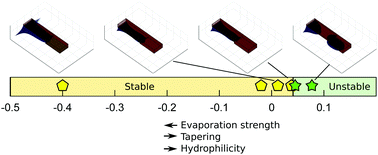当前位置:
X-MOL 学术
›
Soft Matter
›
论文详情
Our official English website, www.x-mol.net, welcomes your
feedback! (Note: you will need to create a separate account there.)
Using evaporation to control capillary instabilities in micro-systems
Soft Matter ( IF 2.9 ) Pub Date : 2017-11-07 00:00:00 , DOI: 10.1039/c7sm01426k Rodrigo Ledesma-Aguilar 1, 2, 3, 4 , Gianluca Laghezza 4, 5, 6, 7 , Julia M. Yeomans 4, 5, 6, 7 , Dominic Vella 4, 6, 8, 9, 10
Soft Matter ( IF 2.9 ) Pub Date : 2017-11-07 00:00:00 , DOI: 10.1039/c7sm01426k Rodrigo Ledesma-Aguilar 1, 2, 3, 4 , Gianluca Laghezza 4, 5, 6, 7 , Julia M. Yeomans 4, 5, 6, 7 , Dominic Vella 4, 6, 8, 9, 10
Affiliation

|
The instabilities of fluid interfaces represent both a limitation and an opportunity for the fabrication of small-scale devices. Just as non-uniform capillary pressures can destroy micro-electrical mechanical systems (MEMS), so they can guide the assembly of novel solid and fluid structures. In many such applications the interface appears during an evaporation process and is therefore only present temporarily. It is commonly assumed that this evaporation simply guides the interface through a sequence of equilibrium configurations, and that the rate of evaporation only sets the timescale of this sequence. Here, we use Lattice-Boltzmann simulations and a theoretical analysis to show that, in fact, the rate of evaporation can be a factor in determining the onset and form of dynamical capillary instabilities. Our results shed light on the role of evaporation in previous experiments, and open the possibility of exploiting diffusive mass transfer to directly control capillary flows in MEMS applications.
中文翻译:

使用蒸发来控制微系统中的毛细管不稳定性
流体界面的不稳定性既代表着限制,也代表着制造小型装置的机会。正如不均匀的毛细管压力会破坏微电子机械系统(MEMS)一样,它们也可以引导新型固体和流体结构的组装。在许多这样的应用中,界面在蒸发过程中出现,因此只是暂时存在。通常假设这种蒸发只是通过一系列平衡构型简单地引导界面,并且蒸发速率仅设置该序列的时间尺度。在这里,我们使用Lattice-Boltzmann模拟和理论分析表明,实际上,蒸发速率可能是决定动态毛细血管不稳定性的发作和形式的一个因素。
更新日期:2017-11-17
中文翻译:

使用蒸发来控制微系统中的毛细管不稳定性
流体界面的不稳定性既代表着限制,也代表着制造小型装置的机会。正如不均匀的毛细管压力会破坏微电子机械系统(MEMS)一样,它们也可以引导新型固体和流体结构的组装。在许多这样的应用中,界面在蒸发过程中出现,因此只是暂时存在。通常假设这种蒸发只是通过一系列平衡构型简单地引导界面,并且蒸发速率仅设置该序列的时间尺度。在这里,我们使用Lattice-Boltzmann模拟和理论分析表明,实际上,蒸发速率可能是决定动态毛细血管不稳定性的发作和形式的一个因素。











































 京公网安备 11010802027423号
京公网安备 11010802027423号